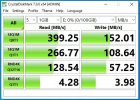Hello,
I recently purchased a server that I would like to use for virtualization and storage, and since I heard many positive reviews, I decided to use the proxmox as my main system. I have no experience using proxmox, so I would like you to point me in the right direction.
I have 4 drive bays, and initially I planned to install two SSDs in the ZFS mirror for proxmox and virtual machines, and two HDDs also in the mirror for storing files. But since I do not have a large number of files that I plan to store there, I decided to limit myself to only two SSDs for now, and I have questions about partitioning the disks.
Could you tell me how I should partition the disk to be able to use it for OS, VMs, as well as leave some space for storing files that will be used by a virtual machine with FreeNAS or OMV, and can I do this when installing the proxmox? At the same time, it is important for me to be able to add HDDs in the future, pass them to the NAS virtual machine, move all files there and free up space on the SSDs for other virtual machines.
I would be very grateful for the tips, since it would like to do everything right initially, so as not to suffer in the future.
I recently purchased a server that I would like to use for virtualization and storage, and since I heard many positive reviews, I decided to use the proxmox as my main system. I have no experience using proxmox, so I would like you to point me in the right direction.
I have 4 drive bays, and initially I planned to install two SSDs in the ZFS mirror for proxmox and virtual machines, and two HDDs also in the mirror for storing files. But since I do not have a large number of files that I plan to store there, I decided to limit myself to only two SSDs for now, and I have questions about partitioning the disks.
Could you tell me how I should partition the disk to be able to use it for OS, VMs, as well as leave some space for storing files that will be used by a virtual machine with FreeNAS or OMV, and can I do this when installing the proxmox? At the same time, it is important for me to be able to add HDDs in the future, pass them to the NAS virtual machine, move all files there and free up space on the SSDs for other virtual machines.
I would be very grateful for the tips, since it would like to do everything right initially, so as not to suffer in the future.




